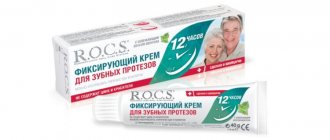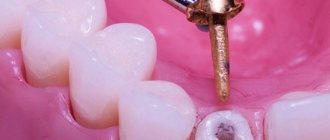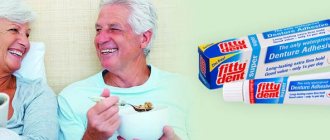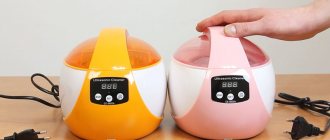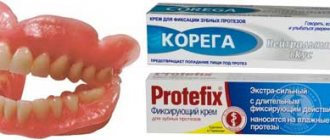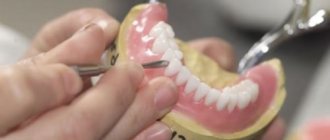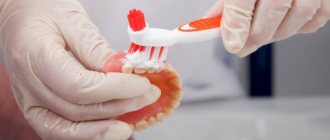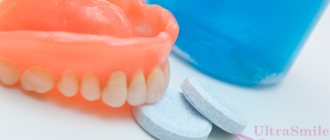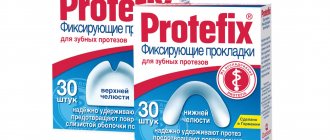About 50% of those who use removable dentures in everyday life indicate that the main problem in their use is insufficient strength of fixation in the oral cavity. This feature is the reason that when performing certain actions (eating, talking, laughing), the prosthesis can noticeably shift relative to its normal position.
To avoid such troubles, it is recommended to use special means that ensure high-quality fixation of dentures in the oral cavity.
Typically, when it comes to nylon and acrylic dentures, creams and gels are used. Gels are not inferior to creams in their functionality and differ from them only in consistency. Creams have a denser structure and are better suited for those who are just starting to use removable dentures.
Below we will consider the main means that are used for reliable and long-term fixation of dentures, their advantages and disadvantages.
What kind of cream is this?
Description, what is it needed for?
Use Corega cream effectively and for preventive purposes to avoid chafing and displacement of individual elements
Corega cream from the German company Corega is presented on the pharmacological market in the form of a plastic substrate of a cement-like fraction, which, when in contact with air, acquires a dense structure.
This feature of the product ensures reliable adhesion of the removable structure to the gums.
To fix it, it is enough to apply this product into the recesses and it will be firmly fixed in the oral cavity.
Considering that the cream fills all the available space between the denture and the gums, the likelihood of even the smallest particles of food getting under it is almost completely excluded.
Using Corega cream is effective and for preventive purposes to avoid chafing, displacement of individual elements and trauma to the gums.
A fixative product for dental structures gives a person confidence, creates a feeling of comfort when using both full and partial removable structures, allowing you to smile and eat freely.
Composition and active ingredients
The effectiveness of Corega cream is ensured by such components as:
- A bonding product for dental structures gives a person confidence and creates a feeling of comfort.
Gantrez salts (sodium, calcium). This connection guarantees high-quality fixation of removable structures.
- Gum arabic is a resin of natural origin, which is used as a component with adhesive properties. In addition, it enhances the activity of gantrez salt.
- Dyes. They are necessary to create an invisible effect for the product used. The presence of a pink tint allows the cream not to stand out against the background of the gums.
- Mineral oils , which give the cream the necessary elasticity and ensure uniform and dosed distribution over the surface.
- Mint or menthol extract. These components are essential to create a pleasant cooling effect and maintain fresh breath throughout the day.
- Liquid paraffin, various flavors, petrolatum. These excipients can be adjusted depending on the type of particular cream.
Release form
Corega cream is available in convenient tubes with a volume of 40 and 70 g.
Instructions for use of Corega gel
Before applying Corega cream, it is first advisable to clarify with what types of dentures it can be used. This retainer works best with nylon inserts and plastic dentures.
In order for the effect of the Corega gel to meet all expectations and demonstrate its adhesive qualities, you need to know the rules for its use. It is also advisable to coordinate its use with the dentist - orthopedist who was involved in prosthetics.
Fixation
Correctly gluing the Korega prosthesis is necessary as follows:
- If there is excess cream that has squeezed out on the sides of the dentures, then it must be removed
The orthopedic structure on which the product will be applied must be clean and dry. To effectively clean the dentures, the manufacturer has provided appropriate tablets for deeper cleansing and removal of pathogenic microorganisms, which need to be dissolved in a container of water and the removable elements placed there.
- In a small volume, you need to apply the cream in the form of strips up to 6 mm long on the insert elements, but not too close to its edges. The application diagram is shown on the packaging. The best option is to place the cream in the recesses of the removable elements. For upper dentures, it can be applied to the protruding areas that are attached to the roof of the mouth. When you first use it, you need to make a minimum number of strips, and depending on your personal feelings, you can increase or decrease them. The main thing is that when using Corega cream and inserts there is no feeling of discomfort in the oral cavity.
- After preparing the dentures, it is recommended to rinse the mouth with clean water to create conditions for better fixation of the dentures.
- Once the insert elements are correctly installed in specific places, they need to be pressed well for a few seconds.
- If there is excess cream that has squeezed out on the sides of the dentures, then it must be removed with an oiled napkin.
- Upon completion of all procedures, the tube with cream should be tightly closed. The fixing cream for insert elements should be stored out of the reach of children and at room temperature.
For information! When applying the ointment to the insert structures, it is important to ensure that moisture does not get into the tube. When interacting with water, the product loses its adhesive properties.
Instructions for using glue on the packaging
Removal
Removal procedure:
- Rinse your mouth with warm, clean water.
- Using soft and gentle rocking movements, remove the removable elements from the gums.
- Clean the surface of the insert structures from any remaining cream and food using a soft-bristled brush and warm water; if necessary, use cleaning aids.
How often and for how long can I use it?
Corega cream can be used once throughout the day. One tube with a volume of 40 g is designed for 21 days; if the consumption during this time is slightly higher, this indicates the need to adjust the insert design.
Using soft and gentle rocking movements, remove the removable elements from the gums.
Folk remedies
You can replace the fixing cream only with a similar product, but cleaning the denture without effervescent tablets is as easy as shelling pears. The simplest methods will come to the rescue, which are safe for the prosthesis, clean dirt well and disinfect surfaces.
The cheapest analogue of Corega tablets is soda and vinegar. Acidic and alkaline environments, when interacting with each other, release large amounts of carbon dioxide, which will help us clean the prosthesis. In addition, baking soda is an excellent antibacterial agent that inhibits the growth of bacteria. There are two ways to use it:
- Clean the denture with soda and put it in acidified water: take regular baking soda, moisten a hard toothbrush and pick up the powdered product. Clean the denture intensively on both sides. Take half a glass of hot water, add 1 teaspoon of vinegar (you can use apple cider vinegar) and place the soda-treated denture there. Let stand for 15 minutes, then rinse with running water.
- Immediately place the prosthesis in water in which a reaction occurs, releasing carbon dioxide: take half a glass of warm water, add a teaspoon of soda, stir until dissolved. Pour in the same amount of vinegar and quickly place the denture in the glass. Please note that foam may rise, so take a deeper container.
Both methods are good, but in the first case the cleaning process can be called complete and of higher quality. Soda is an additional abrasive that removes plaque well.
An analogue of Corega for dentures, or rather cleaning them, is lemon juice and tooth powder. Take a tablespoon of powder and add a teaspoon of lemon juice to it, stir until it becomes a paste and apply the product to the pre-moistened denture using a toothbrush. Let it sit for 20 minutes, then rinse it under running water.
Regular hydrogen peroxide will help to disinfect the prosthesis. It should be applied to the structure and allowed to stand for 10-15 minutes, then rinsed and dried.
In any case, no matter what method you choose, take precautions, since exceeding the recommended dosages can cause a decrease in the strength of the prosthesis and its destruction.
Tags: analogue, Corega analogue, Dentures, Corega cream, Corega tablets
About the author: DrZubastik
- Related Posts
- Which tooth filling is best?
- Aligners or braces: which is better?
- The best toothpastes for tartar: top 10
« Previous entry
Precautionary measures
When using Corega cream, it is advisable to follow certain rules of use in order to avoid negative consequences for the body.
Among which:
- Applying the product to insert structures is allowed only outside the oral cavity; using it in the mouth is strictly prohibited.
- You should be careful not to swallow the cream.
- Do not use the product after its expiration date.
- To maintain the fixing qualities of the cream, the tube should always be tightly closed.
- Hands must be completely dry during application.
- It is not advisable to wash the cap so that excess moisture does not get inside the tube.
Kinds
The table provides a description and cost of each type:
| Name of fixing agent | Description | How much does it cost (price/volume) |
| Extra strong mint | The pharmacological product contains active ingredients in double concentration, which makes it possible to make the fixation of temporary dentures as reliable as possible. Thanks to mint extract, it maintains fresh breath in the mouth and softens gag reflexes in those who feel them when using orthopedic structures. | 223 rub. (40 ml) 332 rub. (70 ml) |
| Refreshing taste | The main distinguishing feature of this product is the absence of zinc in its composition. Considering that this microelement enters the human body when consuming foods, the likelihood of its accumulation is reduced to zero. In case of excess zinc, a person experiences a feeling of trembling and numbness in different parts of the body. Due to the auxiliary ingredient - mint flavor - the paste has a fresh taste. | 250 rub. (40 ml) |
| Neutral taste | The product is made exclusively on the basis of active substances that ensure reliable fastening of insert structures, without the use of zinc or fragrances. | 224 rub. (40 ml) |
Contraindications and side effects
To prevent negative consequences for the body, it is recommended to test the cream first
Considering that you can purchase this product for fixing insert structures without a doctor’s prescription, before use you should familiarize yourself with its composition and method of application in more detail.
The only contraindication for applying the product to dentures is excessive sensitivity to one of the components.
To prevent negative consequences for the body, it is recommended to first test the cream on a small area of the oral mucosa and observe possible manifestations.
If you neglect the recommendations prescribed in the instructions, the following may occur:
- gastrointestinal disorders;
- attacks of nausea and vomiting;
- general malaise;
- allergic reactions;
- When used simultaneously with a zinc-containing agent, there is a high probability of intoxication in the form of nausea, vomiting, drowsiness, loose stools, and dizziness.
Is the cream harmful to the body?
Many buyers are interested in whether Corega cream is harmful. This fixative does not pose any serious threat to the human body, even if accidentally ingested. It can be used by pregnant and lactating women.
Consumer Reviews
- Vladimir, 49 years old: Corega glue is considered one of the best options that can be found on pharmacy shelves. It is easily applied to the prosthesis and evenly fills all voids. Food does not fall under the plate. As for comfort, I can only highlight the advantages. Worth the money.
- Maria, 55 years old: Used various compositions for dentures. I can't say that I liked them. Some walked away from hot drinks, others passed food under the records. Constant discomfort, chafing. Clay Corega is the first among all that could surprise me. For the money this is a very high quality option.
- Evgeniy, 58 years old: I became acquainted with prosthetics about a year ago. I didn’t think about creams to fix them, however, it was necessary. I tried different options, the comfort level was low. Corega glue turned out to be a real find. It is easy to apply and holds the prosthesis tightly. The design does not move during meals. Everything suits me.
Corega glue is rightfully considered one of the best means for securing dentures to the gums. A large number of positive reviews on various resources on the Internet indicate its effectiveness. It is important to follow the instructions during use and do not increase the dosage so as not to harm the body. So, the choice is yours, try different types of glue and find what suits you best individually!
Analogues and prices
Among the main analogues of Corega cream are:
- Lakalut. This is a fairly effective remedy, but hot food and drink can significantly weaken its adhesive property, which will lead to the insertion element coming off.
- Protefex . This is a hypoallergenic product that contains a minimal amount of fragrances that cause redness and a burning sensation in the mouth. Unlike Corega, it must be applied to a damp removable structure. The downside of the cream is its impractical dispenser and the need to store the tube only in a vertical position. Price 180 rub.
- Fittydent. The product is very popular, but it is not suitable for people complaining of tooth sensitivity; it can cause burning or tingling at the place where the denture is attached. The advantages include strong fixation, lack of pronounced taste and traces of the cream. Price 128 rub.
- Forest balm. The base of the fixative is chamomile and rosehip oil. When used, comfortable conditions for eating food are created, removable structures are securely kept in place. In addition, the tube has a very thin spout, which makes application easy. Price 140 rub.
- Rocs. Swiss cream without zinc, after spreading on the surface, creates a tight seal and prevents food particles from passing under the insert structures. The product helps create pleasant fresh breath throughout the day and its adhesive properties do not weaken even when eating hot foods. Price 114 rub.
Fittydent
Lacalut
Forest balm
Protefix
Rocs
Is it possible to whiten dentures?
If hygiene is insufficient, dentures may change their shade. But, unfortunately, it is impossible to bleach it to its original state, especially if a lot of plaque has accumulated and the coloring pigments have penetrated deep into the pores of the material. The doctor can perform polishing - the prosthesis will be smoother, its top layer will be a little ground off, so the structure will be visually lighter. At home, you can try using special whitening tablets (for example, Corega), but you should not overuse them - they can damage the prosthesis materials.


